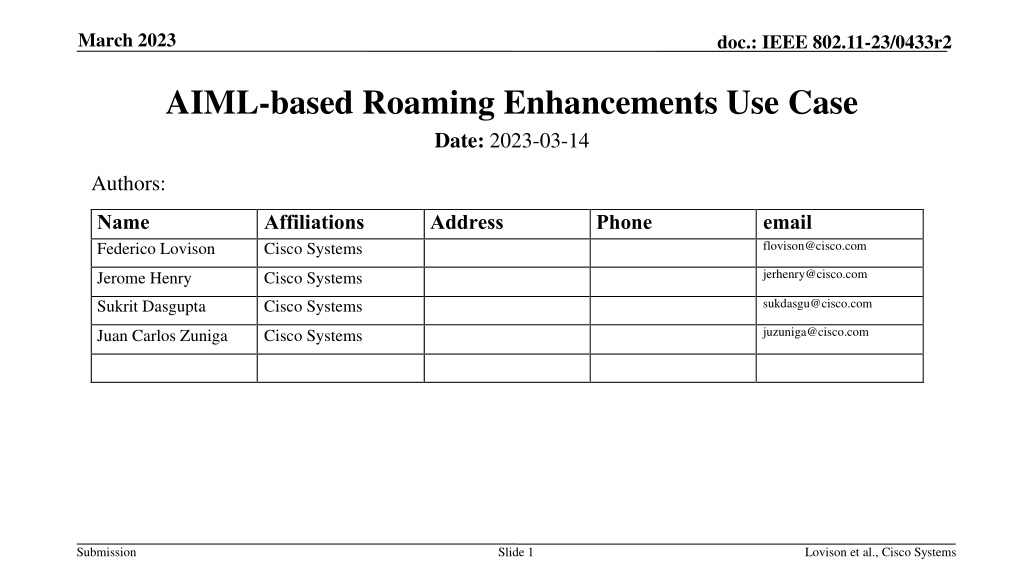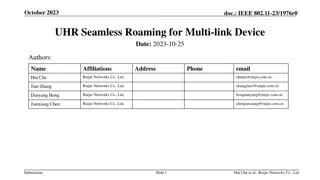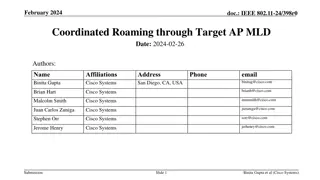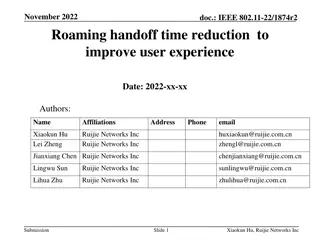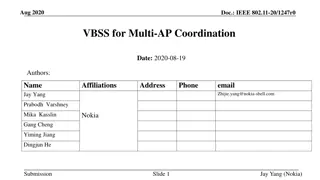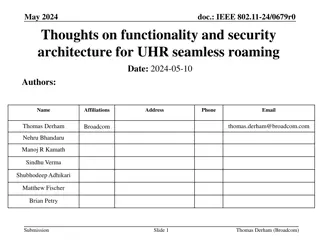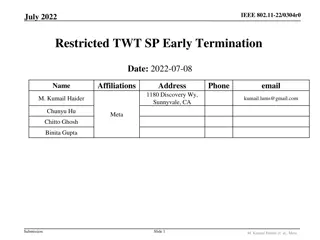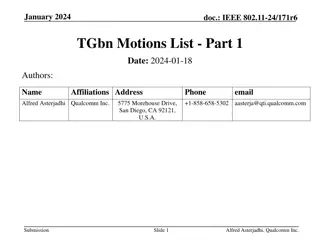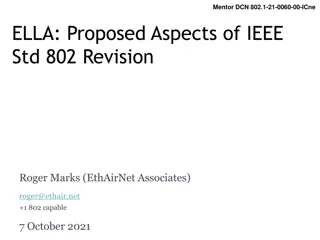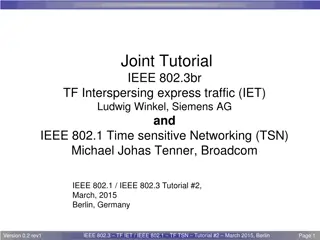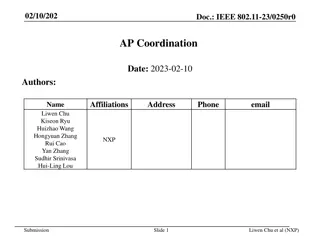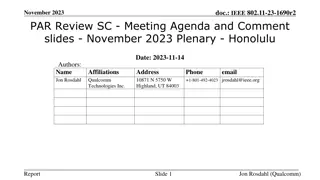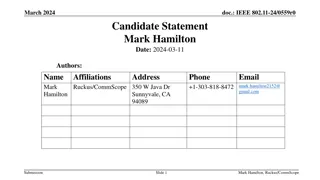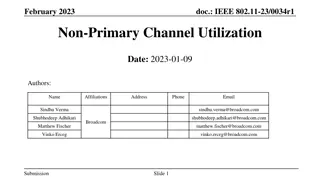AI/ML-Based Roaming Enhancements for IEEE 802.11 Networks
This document presents AI/ML-based enhancements to reduce client latency in highly roaming environments within IEEE 802.11 networks. It proposes using AI/ML algorithms to predict client roaming behavior, prioritize scanning towards probable target access points, and improve overall roaming speed and reliability. Evaluation through impact simulations on real network data with thousands of access points and millions of roaming events demonstrates the potential effectiveness of these enhancements.
Download Presentation

Please find below an Image/Link to download the presentation.
The content on the website is provided AS IS for your information and personal use only. It may not be sold, licensed, or shared on other websites without obtaining consent from the author. Download presentation by click this link. If you encounter any issues during the download, it is possible that the publisher has removed the file from their server.
E N D
Presentation Transcript
March 2023 doc.: IEEE 802.11-23/0433r2 AIML-based Roaming Enhancements Use Case Date: 2023-03-14 Authors: Name Federico Lovison Affiliations Cisco Systems Address Phone email flovison@cisco.com jerhenry@cisco.com Jerome Henry Cisco Systems sukdasgu@cisco.com Sukrit Dasgupta Cisco Systems juzuniga@cisco.com Juan Carlos Zuniga Cisco Systems Submission Slide 1 Lovison et al., Cisco Systems
March 2023 doc.: IEEE 802.11-23/0433r2 Abstract The current document proposes AIML-based enhancements that can reduce the latency experienced by clients when they are operating in a highly roaming environment. Submission Slide 2 Lovison et al., Cisco Systems
March 2023 doc.: IEEE 802.11-23/0433r2 Use of AI/ML to improve roaming experience Campus and enterprise networks experience a high level of roaming clients. Nowadays, client s QoS is severely impacted due to the time a client takes to decide onto which AP it should roam. The proposed use case applies AI/ML to determine the probability of a client to roam to a specific AP, based on the learned client roaming patterns. Multiple possible implementations, e.g., Markov chains, GNN Submission Slide 3 Lovison et al., Cisco Systems
Month Year doc.: IEEE 802.11-23/0433r2 Perspective on 802.11k neighbor reports Sent by the AP upon STA request Indicates neighboring APs BSSID, channel, PHY type and optional elements (see 802.11- 2020 9.4.2.36) Useful to assist STA roaming decision (subset of channels and pre-scanned candidate list) Not all neighbor APs are equally relevant for the clients to make optimal roaming decisions. AP can have tens of neighbors, close and far, STA may not roam to the closest or the farthest (depends on the path) AP is not the STA (does not decide for the STA), and view from the ceiling is different from view from the ground Submission Slide 4 Lovison et al., Cisco Systems
March 2023 doc.: IEEE 802.11-23/0433r2 Proposal for roaming-aware neighbor reports AIML can help make the 11k neighbor reports more useful by deducting roaming patterns to compute the probability of a client roaming to a given target AP Help clients to prioritize scanning towards APs that are more probable targets Improve roaming speed and reliability AI/ML techniques used to compute the neighbour weight Can be complemented with likely roaming point Submission Slide 5 Lovison et al., Cisco Systems
March 2023 doc.: IEEE 802.11-23/0433r2 Usefulness evaluation: Impact Simulation 1 Computation on real network data: Dataset info: 6632 APs 3 Million roaming events Distributed over 3 days Chart info: - Circle: group of APs having the same number of RF and roam neighbors - X-axis: number of RF neighbors - Y-axis: number of roaming neighbors - Circle size: number of APs in the group - Circle color: neighbor list reduction rate, by considering only roam neighbors - Greater impact in high-density environments Lovison et al., Cisco Systems Submission Slide 6
March 2023 doc.: IEEE 802.11-23/0433r2 Usefulness evaluation: Impact Simulation 2 Computation on real network data: - 6632 APs in total - Over 90% of APs would benefit an improvement by just by restricting the neighbor report to the roaming neighbors - 30% of APs have a reduction > 33% - This improvement is not considering the probability assigned to each roam neighbor Submission Slide 7 Lovison et al., Cisco Systems
March 2023 doc.: IEEE 802.11-23/0433r2 Neighbor List Enhancements Adding neighbors weight The neighbor list can be further enhanced by adding the weight* based on the roaming paths/statistics: In this example, out of 15 roaming neighbors, only 3 have a probability higher than ~20% * Fraction of STAs roaming to each APs, and thus likelihood of each AP to be a good roaming candidate -> helps the STA sort the APs Note: the reported MAC addresses are anonymized for privacy reasons as they come from a real production network Submission Slide 8 Lovison et al., Cisco Systems
March 2023 doc.: IEEE 802.11-23/0433r2 Adding neighbors weight : Impact Simulation 1 The roaming-based neighbor weight helps further reducing the neighbor list: Restricting the neighbor list to just APs with a probability higher than 0.2, if there s at least one, else return all roam neighbors The neighbor list would be reduced by more than 66% on 88% of the APs Lovison et al., Cisco Systems Submission Slide 9
March 2023 doc.: IEEE 802.11-23/0433r2 Adding neighbors weight : Impact Comparison The reduction in advertised neighbors improves significantly by adding the roaming-based weight Submission Slide 10 Lovison et al., Cisco Systems
March 2023 doc.: IEEE 802.11-23/0433r2 Conclusion 1 Using AIML to compute the 11k neighbor report list can reduce the number of APs returned to the STA STA benefits: shorter time to discover possible neighbors of roaming possible higher confidence in the list returned by the AP Submission Slide 11 Lovison et al., Cisco Systems
March 2023 doc.: IEEE 802.11-23/0433r2 Implementation Notes The results in the previous slides have been computed modeling the neighbor list as a Markov chain, where the probability distribution is computed using the successful roaming events to each AP s RF neighbor. The advantage of this approach: Simple implementation Can be centrally computed for each AP and periodically re-trained No need to know the full client roaming path Submission Slide 12 Lovison et al., Cisco Systems
March 2023 doc.: IEEE 802.11-23/0433r2 Possible Additional Enhancements 1 Make the list SSID-specific: Clients on different SSIDs may follow different roaming paths (e.g., enterprise scenario; from the building entrance, guests can reach only common areas while employees can also enter the office area) Add time information e.g., time of the day, day of the week The roaming path is likely different at different times of the day, e.g., people entering vs. exiting the building) Use GNN to model the full clients roaming paths: Currently under investigation More complex to maintain and generalize May not provide significant improvement over a simpler approach, also considering encoding in neighbor reports (e.g., having 2-bits to classify neighbors in 4 buckets) Submission Slide 13 Lovison et al., Cisco Systems
March 2023 doc.: IEEE 802.11-23/0433r2 Possible Additional Enhancements 2 Add the mean roaming point (e.g., mean last RSSI/RSNI on AP1 vs first RSSI/RSNI on AP2) Allows the STA to find the mid-point between APs Allows the STA to roam at fast speed instead of waiting for usability threshold failure In low density, helps the STA wait for the right time to scan (battery saving) 60 Mbps Submission Slide 14 Lovison et al., Cisco Systems
doc.: IEEE 802.11-23/0433r2 Without Mean Point Prediction Case 1: Low AP density Case 2: High AP density -75 dBm 400 Mbps 240 Mbps 90 Mbps 45 Mbps 15 Mbps -75 dBm small cells (e.g. office), cell edge is at -62 dBm, STA could roam at 240 Mbps, but waits until -75 dBm to scan - > low efficiency throughput Large cells (e.g. warehouse), cell edge is at -78 dBm, STA scans from -75 dBm, wastes battery looking for a better AP that is not there Submission
Month Year doc.: IEEE 802.11-23/0433r2 Mean Point Prediction Usefulness Evaluation Sample size: 3142 APs, mild-dense deployments, observation period 6 months Candidate roaming point definition (in this test): next AP RSSI 8 dB better than current AP A B 0 iif RSSISTAatB = RSSTSTAatA+8 (dBm) Observation: >50% STAs roam >6 dB after mean point Submission Slide 16 Lovison et al., Cisco Systems
Month Year doc.: IEEE 802.11-23/0433r2 Conclusion 2 - Standards Impact Adding additional information to an 802.11k neighbor list (or an 802.11v BTM request) could benefit the STAs without heavy standard changes (11k/v already allows for optional elements of variable length) Submission Slide 17 Lovison et al., Cisco Systems
March 2023 doc.: IEEE 802.11-23/0433r2 Summary Proposal to include a Roaming Enhancements Use Case to the AIML Technical Report AIML can greatly improve the client experience in a roaming scenario by providing a weighted list of AP roaming candidates The clients can use this info to prioritize scanning based on the probability to roam to specific neighbours, as computed by the infra Backwards compatibility; clients not supporting this feature will simply use the neighbour report ignoring the weights Submission Slide 18 Lovison et al., Cisco Systems
March 2023 doc.: IEEE 802.11-23/0433r2 Straw Poll Do you agree to include a Roaming Enhancements Use Case to the AIML Technical Report? Yes No Abstain Submission Slide 19 Lovison et al., Cisco Systems
